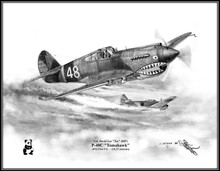 Loading... Please wait...
Loading... Please wait...- Home
- Combat Aircraft/Pencil Drawings ~ Free Shipping
- Curtiss P-40C "Tomahawk" (Col. David Lee "Tex" Hill ~ AVG) ~ Free Shipping
Product Description
The Curtiss P-40 was an American single-engine, single-seat, all-metal fighter and ground attack aircraft that first flew in 1938. It was used in great numbers in World War II. The P-40 design was a modification of the previous P-36; this reduced development time and enabled a rapid entry into production and operational service. When production of the P-40 ceased in November 1944, 13,738 had been built. They were used by the air forces of 28 nations and remained in front line service until the end of the war. Warhawk was the name the United States Army Air Corps adopted for all models, making it the official name in the United States for all P-40s. British Commonwealth air forces gave the name Tomahawk to models equivalent to the P-40B and P-40C, and the name Kittyhawk to models equivalent to the P-40D and all later variants. The P-40's lack of a two-stage supercharger made it inferior to Luftwaffe fighters in high-altitude combat and it was rarely used in operations in Northwest Europe. Between 1941 and 1944, however, the P-40 played a critical role with Allied air forces in five major theaters around the world: China, the Mediterranean, Southeast Asia, the Southwest Pacific and Eastern Europe. The P-40's high altitude performances was not as critical in those theaters where it played an important role as a front line fighter, and later as a fighter-bomber. P-40s first saw wartime service with the British Commonwealth squadrons of the Desert Air Force in August 1941. The Royal Air Force's No. 112 Squadron was among the first to operate Tomahawks, and the unit copied the "shark mouth" nose markings used by Luftwaffe Bf 110 units. The logo was more famously used on P-40s by the Flying Tigers in China. In theaters where high-altitude performance was less important, the P-40 proved an effective fighter. Though it gained a postwar reputation as a mediocre design, suitable only for close air support, more recent research including close scrutiny of the records of individual Allied squadrons indicates that the P-40 performed surprisingly well as an air superiority fighter, at times suffering severe losses, but also taking a very heavy toll on enemy aircraft. The P-40 offered the additional advantage of low cost, which kept it in production as a ground attack fighter long after it was obsolete in air superiority.
Warranty Information
null








